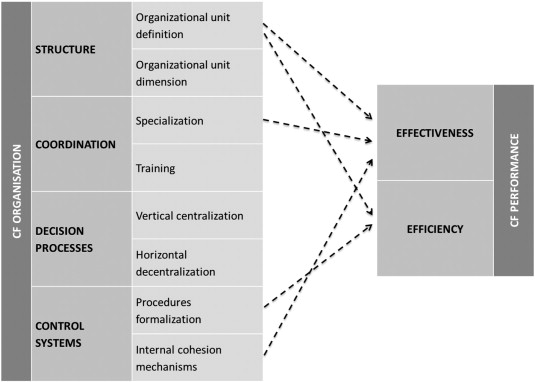22 December 2014:
A research project from Battistella (2014) investigates how eight firms in the telecommunication industry (with sizes ranging from 550 to 120,000 employees) design their organisation to anticipate future trends and detect weak signals in their corporate foresight activities across four dimensions (structure, coordination, decision processes and control systems).
The author describes corporate foresight as a dynamic capability for organisational future orientation, which helps organisations to try to understand the complex forces that drive change, and to accordingly support the decision-making, strategy and product innovation processes.
Fig. 1. Corporate foresight organisation and corporate foresight performance: synthesis of the propositions (Battistella 2014)
In terms of the required organisational structure to succeed in corporate foresight, the criteria include 1) the activation of a dedicated foresight unit, 2) the embedding of foresight activities in a business function, e.g. strategy, marketing or R&D, 3) the formal interrelation among functions (e.g. roles and procedures), 4) the informal interrelation among functions, 5) the activation of specific foresight projects, 6) the alignment with top management or the CEO and the collective capabilities of groups, and 7) the outsourcing of foresight activities to specific research centres or consulting firms to gain an “outside view”.
With regard to the coordination requirements for corporate foresight, the suggested essential partners are strategy, marketing and research teams. In terms of the decision processes, the authors conclude that the solutions are very different, with some companies centralising their activities, and others distributing their foresight activities to top-level management: “one important aspect seems to be the role of the CEO and his/her staff, in terms of leadership and in terms of diffusing a “corporate foresight culture””. It is recommended that control systems can reduce the cost and time required of setting-up a foresight project, but they cannot guarantee the quality of results.
The author concludes that organisations need to “… define a peculiar system for foresight, more “structural” or more “cultural”, to specialise for foresight, to build a control system for procedures and to model internal and external relationships”.
Reference:
Battistella, Cinzia 2014, “The organisation of Corporate Foresight: A multiple case study in the telecommunication industry”, Technological Forecasting and Social Change, September, vol. 87, pp. 60–79.
Link to full text article:
http://www.sciencedirect.com/science/article/pii/S0040162513002801

